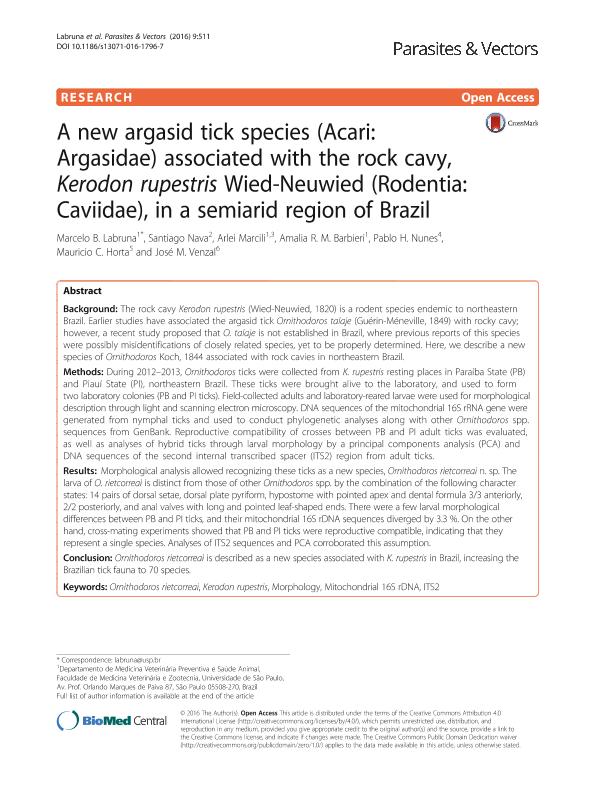Mostrar el registro sencillo del ítem
dc.contributor.author
Labruna, Marcelo B.
dc.contributor.author
Nava, Santiago

dc.contributor.author
Marcili, Arlei
dc.contributor.author
Barbieri, Amalia R. M.
dc.contributor.author
Nunes, Pablo H.
dc.contributor.author
Horta, Mauricio C.
dc.contributor.author
Venzal, José M.
dc.date.available
2019-03-12T16:21:33Z
dc.date.issued
2016-09
dc.identifier.citation
Labruna, Marcelo B.; Nava, Santiago; Marcili, Arlei; Barbieri, Amalia R. M.; Nunes, Pablo H.; et al.; A new argasid tick species (Acari: Argasidae) associated with the rock cavy, Kerodon rupestris Wied-Neuwied (Rodentia: Caviidae), in a semiarid region of Brazil; BioMed Central; Parasites and Vectors; 9; 1; 9-2016; 511
dc.identifier.uri
http://hdl.handle.net/11336/71457
dc.description.abstract
Background: The rock cavy Kerodon rupestris (Wied-Neuwied, 1820) is a rodent species endemic to northeastern Brazil. Earlier studies have associated the argasid tick Ornithodoros talaje (Guérin-Méneville, 1849) with rocky cavy; however, a recent study proposed that O. talaje is not established in Brazil, where previous reports of this species were possibly misidentifications of closely related species, yet to be properly determined. Here, we describe a new species of Ornithodoros Koch, 1844 associated with rock cavies in northeastern Brazil. Methods: During 2012-2013, Ornithodoros ticks were collected from K. rupestris resting places in Paraíba State (PB) and Piauí State (PI), northeastern Brazil. These ticks were brought alive to the laboratory, and used to form two laboratory colonies (PB and PI ticks). Field-collected adults and laboratory-reared larvae were used for morphological description through light and scanning electron microscopy. DNA sequences of the mitochondrial 16S rRNA gene were generated from nymphal ticks and used to conduct phylogenetic analyses along with other Ornithodoros spp. sequences from GenBank. Reproductive compatibility of crosses between PB and PI adult ticks was evaluated, as well as analyses of hybrid ticks through larval morphology by a principal components analysis (PCA) and DNA sequences of the second internal transcribed spacer (ITS2) region from adult ticks. Results: Morphological analysis allowed recognizing these ticks as a new species, Ornithodoros rietcorreai n. sp. The larva of O. rietcorreai is distinct from those of other Ornithodoros spp. by the combination of the following character states: 14 pairs of dorsal setae, dorsal plate pyriform, hypostome with pointed apex and dental formula 3/3 anteriorly, 2/2 posteriorly, and anal valves with long and pointed leaf-shaped ends. There were a few larval morphological differences between PB and PI ticks, and their mitochondrial 16S rDNA sequences diverged by 3.3 %. On the other hand, cross-mating experiments showed that PB and PI ticks were reproductive compatible, indicating that they represent a single species. Analyses of ITS2 sequences and PCA corroborated this assumption. Conclusion: Ornithodoros rietcorreai is described as a new species associated with K. rupestris in Brazil, increasing the Brazilian tick fauna to 70 species.
dc.format
application/pdf
dc.language.iso
eng
dc.publisher
BioMed Central
dc.rights
info:eu-repo/semantics/openAccess
dc.rights.uri
https://creativecommons.org/licenses/by-nc-sa/2.5/ar/
dc.subject
Its2
dc.subject
Kerodon Rupestris
dc.subject
Mitochondrial 16s Rdna
dc.subject
Morphology
dc.subject
Ornithodoros Rietcorreai
dc.subject.classification
Biología Celular, Microbiología

dc.subject.classification
Ciencias Biológicas

dc.subject.classification
CIENCIAS NATURALES Y EXACTAS

dc.subject.classification
Salud Ocupacional

dc.subject.classification
Ciencias de la Salud

dc.subject.classification
CIENCIAS MÉDICAS Y DE LA SALUD

dc.title
A new argasid tick species (Acari: Argasidae) associated with the rock cavy, Kerodon rupestris Wied-Neuwied (Rodentia: Caviidae), in a semiarid region of Brazil
dc.type
info:eu-repo/semantics/article
dc.type
info:ar-repo/semantics/artículo
dc.type
info:eu-repo/semantics/publishedVersion
dc.date.updated
2019-02-25T18:46:30Z
dc.identifier.eissn
1756-3305
dc.journal.volume
9
dc.journal.number
1
dc.journal.pagination
511
dc.journal.pais
Reino Unido

dc.journal.ciudad
Londres
dc.description.fil
Fil: Labruna, Marcelo B.. Universidade de Sao Paulo; Brasil
dc.description.fil
Fil: Nava, Santiago. Consejo Nacional de Investigaciones Científicas y Técnicas. Centro Científico Tecnológico Conicet - Santa Fe; Argentina. Instituto Nacional de Tecnología Agropecuaria. Centro Regional Santa Fe. Estación Experimental Agropecuaria Rafaela; Argentina
dc.description.fil
Fil: Marcili, Arlei. Universidade de Sao Paulo; Brasil
dc.description.fil
Fil: Barbieri, Amalia R. M.. Universidade de Sao Paulo; Brasil
dc.description.fil
Fil: Nunes, Pablo H.. Universidade Federal da Integração Latino-Americana; Brasil
dc.description.fil
Fil: Horta, Mauricio C.. Universidade Federal do Vale do São Francisco; Brasil
dc.description.fil
Fil: Venzal, José M.. Universidad de la República; Uruguay
dc.journal.title
Parasites and Vectors

dc.relation.alternativeid
info:eu-repo/semantics/altIdentifier/url/https://parasitesandvectors.biomedcentral.com/articles/10.1186/s13071-016-1796-7
dc.relation.alternativeid
info:eu-repo/semantics/altIdentifier/doi/http://dx.doi.org/10.1186/s13071-016-1796-7
Archivos asociados
